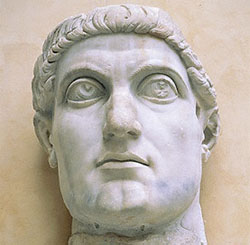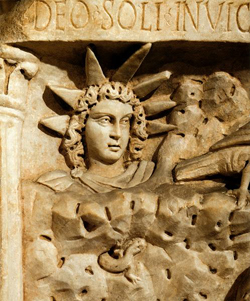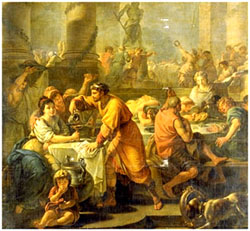With Christ's birth date unknown, selecting Dec. 25 has its advantages
Much of Holiday celebrations tied to pagan celebrations
By Mike Hudson
Jesus wasn’t born on Christmas. Everybody knows that. You might as well believe in Santa Claus.
The Bible gives no date or year for Jesus’ birth, and the earliest gospel – St. Mark’s – introduces us to an adult Jesus being baptized. This would suggest that the earliest Christians had little interest in when he was born.
A Scythian monk named Dionysius Exiguus used a close interpretation of the New Testament to come up with the year of Jesus’ birth, what we now call 1 A.D., or the beginning of the Christian Era, but later scholars uncovered serious flaws in the old monk’s methodology.
Clement, the Bishop of Alexandria in 215 A.D. said Jesus was born on November 18, and the DePascha Computus, an anonymous document found in North Africa dating to around 245 A.D. said he was born on March 28. More recently, Joseph A. Fitzmyer – Professor Emeritus of the Catholic University of America, member of the Pontifical Biblical Commission and former president of the Catholic Biblical Association, wrote that Jesus was born on September 11.
So how come we celebrate it on December 25?
In ancient Babylon, the feast of the Son of Isis, the Goddess of Nature, was celebrated on December 25. Raucous partying, gluttonous eating and drinking, and gift giving were traditions of this feast.
And Roman pagans first introduced the holiday called Saturnalia, a weeklong period of lawlessness and debauchery celebrated during December 17 to 25 long before Jesus was born. Law dictated that no one could be prosecuted for damaging property or injuring people that week, and authorities chose an enemy of the state to represent the “Lord of Misrule.”
Local communities picked out a victim, who was forced to indulge in food, sex and binge drinking until the 25th, when he or she was ceremonially sacrificed to bring good luck in the coming year. The renewal of light and the coming of the New Year was celebrated in the Roman Empire at the Dies Natalis of Sol Invictus, the "Birthday of the Unconquerable Sun," on December 25.
It wasn’t until around 300 A.D. that the Catholic Church attempted to co-opt the Roman holiday, hoping to win new converts from among the pagans who still celebrated Saturnalia.
In England, as the authorized Bible became available to the common people by the decree of King James II in 1611 A.D., people began to discover the pagan roots of Christmas. Because of its known pagan origins, Christmas was banned by the Puritans in the New World and its observance was illegal in Massachusetts between 1659 and 1681 A.D.
Pope Paul II added a festive touch to the Christmas celebration in 1466 A.D., when he ordered that all the Jews in Rome had to race naked through the streets on Christmas morning. Before they were run, the Jews were richly fed, so as to make the race more difficult for them and more amusing for the Christian spectators.
Meanwhile, up in Scandinavia, church leaders were faced with a different kettle of fish, the gods of Norse mythology. The cutting of evergreen trees for display inside people’s homes was long associated with the celebration of the Winter Solstice, and the church formally sanctioned the practice as a part of the burgeoning Christmas tradition. The evergreen tree was a symbol of the essence of life and was regarded as a phallic symbol in fertility worship.
Likewise, kissing under the mistletoe represents a blending of Saturnalia’s sexual license with the ancient Druid custom of using poison made from the plant’s leaves to sacrifice victims at the time of the Solstice in the hope that the days might once again become longer. The white berries of mistletoe were believed by pagans to represent droplets of the semen of the sun god.
Witches and other pagans regarded the red holly as a symbol of the menstrual blood of the queen of heaven, also known as Diana, and the holly wood was used by witches to make wands.
For the Norse, Yule was the celebration of the old pagan Sun god Mithras, born on the shortest day of the year, with the days becoming longer and warmer as he grew and matured. The very word “Yule” translates to “wheel,” which was the pagan symbol for the sun.
Jolly old St. Nick himself was born in Turkey back in 245 A.D. and wasn’t canonized until the 19th Century. But he managed to become the center of a tenth century German Santa Claus cult that had him donning heavy winter clothing and riding a flying horse on the night of December 6 to distribute gifts for children.
December 6 was the day of Nicholas’s death but church leaders, having already established December 25 as Christmas, moved the Santa Claus observation to that date in order to convert even more of the northern Pagans.
In this country, Washington Irving incorporated the Santa Claus story in his 1809 satire of Dutch culture, “Knickerbocker History,” which was in turn read by Clement Moore, a professor at Union Seminary, who was inspired to write a poem that began “It was the night before Christmas…”
And the rest, as they say, is history.
Santa Claus as we know and love him today was actually a guy named Lou Prentice, who was a cheerful, chubby-faced drinking buddy of the Swedish commercial artist Haddon Sundblom. In 1931, Sundblom was hired by the Coca Cola Corporation to create a coke-drinking Santa, insisting that his fur-trimmed suit be bright, Coca Cola red.
All of this stuff remains pretty controversial among strict fundamentalist Christians. They argue that the celebration of Christmas is little more than pagan idolatry. A website belonging to an outfit calling itself the Last Trumpet Ministries is representative.
“To say that Jesus was born on December 25th is a lie! Trees, wreaths, holly, mistletoe and the like are strictly forbidden as pagan and heathen!” it states. “Can we worship and honor God by involving ourselves with customs and traditions, which God Himself forbade as idolatry? Can we obey through disobedience? So what is right about Christmas? Nothing!”
At the risk of spending eternity burning in hell, we’ll disagree.
Merry Christmas to all.
And to all a Good Night.


